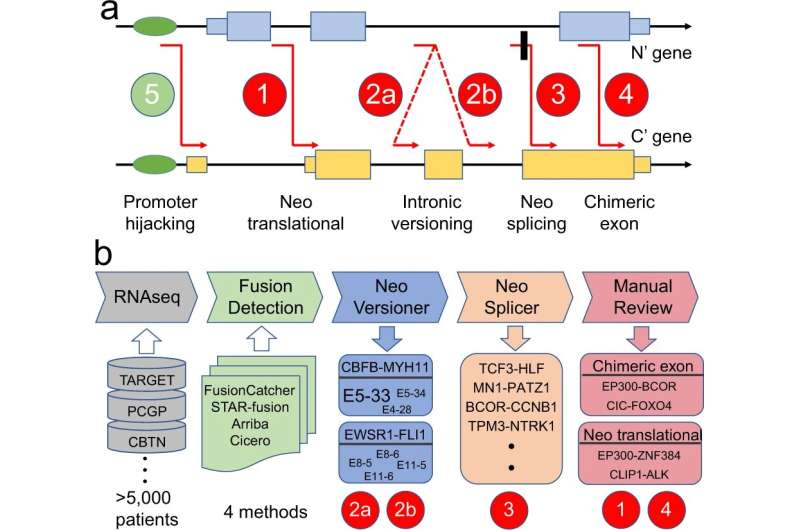This article has been reviewed according to Science X's editorial process and policies. Editors have highlighted the following attributes while ensuring the content's credibility:
fact-checked
peer-reviewed publication
trusted source
proofread
Tool targets cancer-causing fusions' weak spot

Scientists at St. Jude Children's Research Hospital comprehensively characterized oncogenic fusions in pediatric cancer, providing proof-of-principle for genetic engineering-based therapies.
The scientific foundation needed to work on curing a class of cancer-causing mutations is here, in the form of a tool from St. Jude Children's Research Hospital. Computational biologists at St. Jude comprehensively categorized and identified the mechanism underlying oncogenic fusions in pediatric cancer cells. Oncogenic fusions are mutations that drive cancer.
The researchers showed that targeting them with genome editing tools such as CRISPR has the potential to cure certain tumors. The findings were published today in Nature Communications.
For decades, oncologists have observed mutations that combine two genes, resulting in the creation of a hybrid protein that fuels cancer (fusion oncogenes and fusion oncoproteins). Targeting fusions using drugs has shown some success because cancer cells depend on the fusion proteins to thrive. However, this approach has been plagued with difficulties driven in part by a lack of understanding about how fusions work and the side effects of therapy.
"We've made something similar to the periodic table in chemistry for types of oncogenic fusions," said senior and co-corresponding author Xiaotu Ma, Ph.D., St. Jude Department of Computational Biology. "By cataloging the underlying mechanisms, we've given other scientists the ability to study fusions in better detail."
"It is now well established that fusion oncoproteins drive many pediatric cancers," said co-corresponding author Jeffery Klco, M.D., Ph.D., St. Jude Department of Pathology. "The Ma lab has comprehensively characterized the full spectrum of oncogenic fusions in childhood cancer, providing the community which a rich resource that can be mined to develop more predictive clinical tests while also suggesting potential therapeutic strategies for some tumor types. This will be a hugely impactful study."
A proof-of principle that genome editing can cure oncogenic fusions
The problem for many cancers driven by oncogenic fusions is that they cannot be treated with existing drugs. This is typically because one or both normal proteins created by the hybridized genes are essential in healthy cells. Drugging the fusion protein therefore also harms healthy cells, causing major side effects.
But the new St. Jude tool lays a foundation for using genome editing to cure cancer. The mutations that cause fusion genes are only present in cancer cells. That means a highly specific genetic engineering tool, such as the CRISPR-Cas9 system, could selectively cut out the fusion gene in cancer cells—removing their ability to make the hybrid protein, leading to a cure.
"The fusion gene specific sequence only exists in cancer cells," said first author Yanling Liu, Ph.D., St. Jude Department of Computational Biology. "It wouldn't target any normal cells. We used CRISPR-Cas9 to perturb the fusion specific alleles in two cancer cell lines and killed them."
"We were able to demonstrate the therapeutic potential of genome editing using CRISPR-Cas9 and in vitro cancer cell line models" said co-corresponding author Shondra Pruett-Miller, Ph.D., St. Jude Center for Advanced Genome Engineering director. "We believe this is just the tip of the iceberg in terms of how we might be able to harness the power of genome editing to target these oncofusions."
Hope on the horizon for genome editing cures
Killing the cell lines provides a proof-of-principle for a genome editing cure for these cancers. It also showed the difficulties that lay ahead of such cures. The cell lines were derived from pediatric cancers that currently have a poor prognosis, even with treatment. One line was simply killed by the genome editing.
However, the other cancer cell line unexpectedly compensated by using multiple splice variants. Splice variants are different sequences of RNA derived from the same DNA region. When the St. Jude scientists disrupted all splice variants of oncogenic fusion in the second cell line, they successfully killed the cancer cells.
Pre-emptively identifying splice variants is technically challenging and current genome editing technologies are not yet efficient enough to bring into the clinic for these diseases.
Predicting clinical outcomes and pushing research forward
Even with the challenges facing its use in therapy, the computational tool already predicts some clinical outcomes. The St. Jude authors were able to explain why a small group of pediatric patients with relapsed acute myeloid leukemia (AML) had poor outcomes. They found subtle differences in the oncogenic fusion mutations, which explained survival outcomes better than any existing clinical diagnostics.
The result demonstrated that the tool can be used for clinical predictions, which will help physicians choose more personalized and effective treatments for patients in the future.
More information: Yanling Liu et al, Etiology of oncogenic fusions in 5,190 childhood cancers and its clinical and therapeutic implication, Nature Communications (2023). DOI: 10.1038/s41467-023-37438-4



















